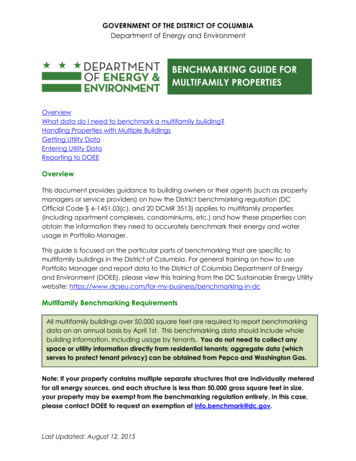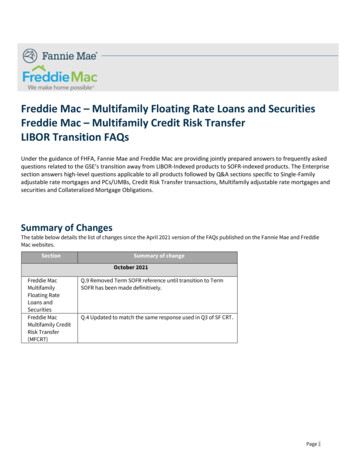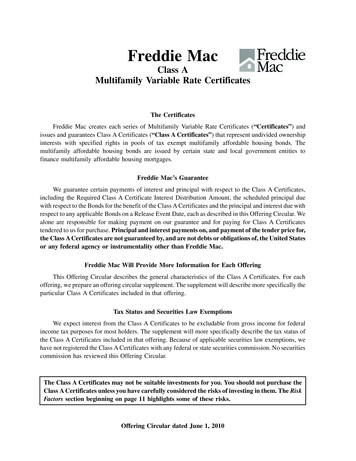
Transcription
GOVERNMENT OF THE DISTRICT OF COLUMBIADepartment of Energy and EnvironmentBENCHMARKING GUIDE FORMULTIFAMILY PROPERTIESOverviewWhat data do I need to benchmark a multifamily building?Handling Properties with Multiple BuildingsGetting Utility DataEntering Utility DataReporting to DOEEOverviewThis document provides guidance to building owners or their agents (such as propertymanagers or service providers) on how the District benchmarking regulation (DCOfficial Code § 6-1451.03(c), and 20 DCMR 3513) applies to multifamily properties(including apartment complexes, condominiums, etc.) and how these properties canobtain the information they need to accurately benchmark their energy and waterusage in Portfolio Manager.This guide is focused on the particular parts of benchmarking that are specific tomultifamily buildings in the District of Columbia. For general training on how to usePortfolio Manager and report data to the District of Columbia Department of Energyand Environment (DOEE), please view this training from the DC Sustainable Energy Utilitywebsite: -in-dcMultifamily Benchmarking RequirementsAll multifamily buildings over 50,000 square feet are required to report benchmarkingdata on an annual basis by April 1st. This benchmarking data should include wholebuilding information, including usage by tenants. You do not need to collect anyspace or utility information directly from residential tenants; aggregate data (whichserves to protect tenant privacy) can be obtained from Pepco and Washington Gas.Note: If your property contains multiple separate structures that are individually meteredfor all energy sources, and each structure is less than 50,000 gross square feet in size,your property may be exempt from the benchmarking regulation entirely. In this case,please contact DOEE to request an exemption at info.benchmark@dc.gov.Last Updated: August 12, 2015
DOEE Energy Benchmarking Guide for Multifamily PropertiesWhat data do I need to benchmark a multifamily building?Basic Property information: Facility NameStreet AddressYear BuiltDC Real Property ID or IDs: Your Square-Suffix-Lot (SSL), Parcel, or CondominiumComplex Number. If your property covers multiple parcels or tax lots, and is not acondominium, enter all included SSL/parcel numbers. Condominium buildingsare assigned a single complex number (the Square-Suffix-Regime number). Thesenumbers can be looked up at l Gross Floor Area (Gross Floor Area is the total floor area, expressed in squarefeet, measured from the principal exterior surfaces of the building(s) and notincluding parking area)Occupancy PercentageMultifamily Use Information: Gross floor area (sq. ft.)Total number of residential living unitsTotal number of residential living units in a low-rise setting (1-4 stories)Total number of residential living units in a mid-rise setting (5-9 stories)Total number of residential living units in a high-rise setting (10 or more stories)Number of bedroomsGovernment subsidized housing (Yes or No)Resident population typePercent of floor area that is heated (in 10% increments)Percent of floor area that is cooled (in 10% increments)Whole Building Utility Data: Electricity Consumption by monthNatural Gas Consumption by monthWater Consumption by month(And, if applicable, Fuel Oil Consumption, by delivery)Note that none of this information requires collecting any data from individual tenants.If you do not enter values manually for any of the use characteristics, and let PortfolioManager use default values instead, your ENERGY STAR score will not be accurate.DOEE generally does not allow the use of default values for benchmarking.Page 2 of 20
DOEE Energy Benchmarking Guide for Multifamily PropertiesHandling Properties with Multiple BuildingsIf your property contains only one structure, you may skip to the next section, “ListingReal Property ID”Many multifamily properties are comprised of multiple buildings. It is usually moreconvenient to group these together as a single building in Portfolio Manager ratherthan doing each one separately (in Portfolio Manager this is referred to as a “campus”);the ENERGY STAR score is equally valid for one building or a group of buildings. Per thebenchmarking regulation, if your property has meters shared across multiple buildings,or building systems (such as a central gas furnace) shared across multiple buildingswithout separate sub-metering, then the energy use cannot be attributed to anyindividual building. In such cases, the building must be benchmarked as single propertyin Portfolio Manager. If the property covers multiple tax lots and is not a condominium,you will need to also enter all tax lot numbers in the DC Real Property ID field.Listing multiple buildings in a single propertyWhen initially creating a property, Property Use Detail will ask how many buildings areconsidered to be part of the property.If, after the property has been created, you need to change this to reflect multiplebuildings, go to the Details tab and click on the Edit button in the Basic Information box,as seen below:Once there, scroll down to the Property Use Detail box and simply indicate how manybuildings are included in the property.Page 3 of 20
DOEE Energy Benchmarking Guide for Multifamily PropertiesCreating a CampusWe recommend against using this option for benchmarking, as creating a campus ismore complicated than grouping the buildings together. However, if you are interestedin structuring your buildings as a campus, we suggest looking at this guide created byEnergy /tools/How to Benchmark a Campus 20140908 508.pdfPage 4 of 20
DOEE Energy Benchmarking Guide for Multifamily PropertiesListing DC Real Property ID(s)You need to enter your real DC Real Property ID when benchmarking—without this,DOEE may not be able to match your submission to a covered tax lot and you may notbe marked as being in compliance.To list a DC Real Property ID, go to the Unique Identifiers box in the Details tab:Once you click on Edit, scroll down to Standard IDs, find “District of Columbia RealProperty Unique ID” in the drop down list, and type the ID. If multiple IDs are associatedwith the property, separate each with a semi-colon, as shown below:Page 5 of 20
DOEE Energy Benchmarking Guide for Multifamily PropertiesGetting Utility DataUseful terms Whole building utility data: Data for the total consumption of all energy andwater used in the building. This includes owner-paid utility information, tenantusage information, data centers, ground-floor retail stores and restaurants, etc.This may be in the form of one central meter or a combination of house andtenant meters.Aggregate data: Monthly electricity or natural gas usage figures that account formultiple tenants (possibly the entirety of tenants in the building). There must be atleast five tenants to obtain aggregate data in the District of Columbia.Why is whole-building data needed?Portfolio Manager generates a 1-100 score for the efficiency of the building bycomparing the buildings to other similar buildings nationwide, adjusting for size,weather, and use factors. (The number of the score represents the percentile yourbuilding is in; a building with a score of 75 performs better than 75% of similar buildings.)These comparisons are based on a national survey of buildings using whole-buildingdata. Without data on the total energy consumption of your building, including tenantusage, your energy use will be underreported and your score will be artificially inflated(often to 100).Do you need aggregate data?If the owner or manager of a multifamily property pays all the energy and water bills forthe property, there is no need to request aggregated data. You can simply collect andenter into Portfolio Manager the energy and water consumption for the “master” or“house” meters for all energy sources and water. Multifamily buildings usually are almostalways master-metered for water, and usually master-metered if they use natural gas.However, in some cases, tenants may have individual gas meters. Additionally, manytenants have their own electricity meters. Whenever you have 5 or more tenants withtheir own meters, you must request aggregated whole-building data from the utilitycompany.Obtaining aggregate dataBoth Pepco and Washington Gas can work with property owners to obtain aggregatedata usage for properties with 5 or more tenants, either residential or non-residential.Pepco has also developed a tool called Resource Advisor, which allows propertyowners/managers to obtain aggregate data that is automatically uploaded intoPortfolio Manager on a monthly basis.Page 6 of 20
DOEE Energy Benchmarking Guide for Multifamily PropertiesTo obtain aggregate data from both Pepco and Washington Gas, you’ll need to knowthe building address, the service period you are requesting, and the meter numbers (oraccount numbers). Note that the meter numbers are not the same as the accountnumber; they are not tied to an individual and should not change if tenants move in orout of the building. An address alone may not be enough for the utility companies toidentify the complete set of meter data.How long does it take to get the data?Both Pepco and Washington Gas state that it can take up to thirty days to provide youwith the aggregate data. Athough they can often process your request faster, weadvise you to make your request at least one month in advance of needing the data.How do I obtain the meter numbers?Many properties keep the meter numbers on record; your property management ormaintenance staff may have them. However, if the records are unavailable then youwill have to physically check the meters. In many multifamily properties, the meters aregrouped together either just outside the building, in the basement, or in a room oneach floor. See the picture below for an example.In rare cases, such as with some condominiums, the meters may be located on theresidents’ property or may be otherwise inaccessible without permission from theresidents. If you believe this is the case, you may be able to get aggregate data fromPepco and/or Washington Gas based on a list of addressess. If that does not work, youmay need to gather the meter numbers from your tenants. Contact the utilities to findthe proper solution and make sure to prepare well in advance so you will havesufficient time prior to the deadline.Electric MetersGas MetersPage 7 of 20
DOEE Energy Benchmarking Guide for Multifamily PropertiesRequesting Aggregate Utility DataElecticity: PepcoTo get aggregate data from Pepco, you request the data and get signed up for their“Resource Advisor” tool. With Resource Advisor, you now have the ability toautomatically load your building’s electricity data directly into Portfolio Manager tocalculate your ENERGY STAR score. Resource Advisor can also be used to requestwhole-building data for your building electronically. There is no fee for using ResourceAdvisor.Pepco Benchmarking gement/energybenchmarking.aspxPepco Data Request est%20for%20Aggregate%20Usage%20Data(1).xlsxPepco Key Account Support Team:Phone Inquiries: (202) 872-2040Fax data requests to: (202) 872-3225E-mail to: kast-south@pepco.comTo request the data, fill out the data request sheet, including all meter numbers, andemail it to Pepco. When filling out the form, please make sure to include your DC Realproperty ID (your SSL, Parcel, or Complex number) and not your employer tax ID in thefield for tax ID. You may need to create additional rows in the excel spreadsheet to fitall your meters.The form looks like this:Page 8 of 20
DOEE Energy Benchmarking Guide for Multifamily PropertiesRequest for Aggregated Building Electricity Consumption DataPlease provide the building information requested in the highlighted fields, read and indicate acceptance of the termsfor the release of energy consumption data at the end of this form and return this document as instructed below.Thank you.Name of RequestorCompanyBuilding Service AddressTelephoneFax No.Email AddressDC Property Tax IDService PeriodFrom (Month-Year)To (Month-Year)Meter Numbers (or Pepco Account Numbers)Once you have entered the information into the Pepco Data Request Sheet and sent itto Pepco, they will set you up with a Resource Advisor account. Pepco will send you aguide with step-by-step instructions once they’ve been able to obtain the right data. Itcan take more than 24 hours to get the Resource Advisor account to transfer the datainto Portfolio Manager, so plan accordingly.Once you are set up in Resource Advisor, you can then either download the data outof Resource Advisor and manually input it into Portfolio Manager, or set PortfolioManager and Resource Advisor up to electronically transfer the data. We recommendthat you set up the electronic sync. It takes more time but is worth it as your data will beautomatically updated each month, making it easy for you to track your energy use,get updates of any mistakes, and benchmark and report your building to DOEE muchfaster next year.If you download the data and import it manually, follow the example provided belowfor Natural Gas, entitled “Creating a Meter and Entering Usage.”Please send this form to:You can send this request by email to:- antset Teamup Resource Advisorto transfer the data to Portfolio Manager for you,EP 7642pleaseconsult Pepco’s detailed step-by-stepguide on “Connecting Portfolio Manager701 9th St. NWTelephone202-872-2040Washington,DC 20068Advisor.”Fax202-872-3225toResourceOnce Resource Advisor and Portfolio Manager are synced, you can clearly see whichmeter information comes from Resource Advisor.Page 9 of 20
DOEE Energy Benchmarking Guide for Multifamily PropertiesNext, make sure the tenant meters are included in the performance metrics. Go to themeters tab and look for the box that says “Meters for Performance Metrics.”Page 10 of 20
DOEE Energy Benchmarking Guide for Multifamily PropertiesOnce there, make sure you have checked the box for each meter that contributes tothe building’s energy and ensure the option “These meter(s) account for the totalenergy/water consumption for this property” is checked for both energy and watermeters.Make sure that all meters thatcontribute to the building’s totalenergy consumption are selected.Check these!Page 11 of 20
DOEE Energy Benchmarking Guide for Multifamily PropertiesNatural Gas: Washington GasWashington Gas Benchmarking hmarkingWashington Gas Aggregated Data Request Form (copy and paste into ggregate%20Usage%20Data2.pdfWashington Gas Contact Info:Phone: (703) 750-4773 (Choose Option 2)Fax utility waiver requests to: (703) 750-4441Email aggregate data requests to: aggregateddata@washgas.comSingle meter usage request: customersupport@washgas.com or custsrv@washgas.comOnce you have entered the information into the Washington Gas Data Request Sheet,you will receive an email with the aggregate data, which you can then enter intoPortfolio Manager.Aggregated data from Washington Gas, for example, may look something like this:Washington Gas555 Sample StNatural Gas e you have the data you need, enter it into Portfolio Manager. There is a way toupload a spreadsheet, but to prevent errors we recommend manually copying in theentries.Page 12 of 20
DOEE Energy Benchmarking Guide for Multifamily PropertiesFor clarity and simplification, we recommend having a separate meter for aggregatetenant data and at least one separate one for owner-paid data. An ideal set-up in theMeters Tab of the property would look something like this:Page 13 of 20
DOEE Energy Benchmarking Guide for Multifamily PropertiesCreating a Meter and Entering Usage (using Natural Gas as an example)To get started with creating a meter, go to the Meters tab. On the right side of thepage it will list any meters you have already created (with separate sections for Energyand Water meters) and give you the option to add another meter.Page 14 of 20
DOEE Energy Benchmarking Guide for Multifamily PropertiesThere you can select what types of meters you want to set up, and how many of each.As you can see below, we have indicated that we want to create a single Natural Gasmeter.When you click “Get Started!” the next page will allow you to enter information aboutthe meter before you actually enter any usage.Meter Name: This can be any name you choose. We recommend choosing one that isclearly identifiable from the other meters you create to eliminate future confusion.Page 15 of 20
DOEE Energy Benchmarking Guide for Multifamily PropertiesUnits: The units are what measurement type is shown when you receive utility bills. Makesure this is accurate before you start entering bills. As you can see from the imagebelow, we have selected therms as the unit of measurement for natural gas.Date Meter became Active: This refers to the date the meter was installed, not today’sdate. You don’t need to necessarily know exactly when the meter was installed; justmake sure the date is before any usage occurs. If you are recording usage for 2013,make sure this date is before 2013.In Use: Keep this checked. It indicates that the meter is still being used.Date Meter became Inactive: This is only filled out if the meter is no longer active, butyou still want to keep its usage on record. Otherwise, leave it blank.After you click “Create Meters” you are ready to start entering usage data. Rememberthat you need to have a separate entry for each billing period; you cannot create oneentry that summarizes the entire year’s usage. There is no need to enter cost; when youreport benchmarking to DOEE, this information will not show.To add another entry, click on “Add Another Entry,” as shown below:Page 16 of 20
DOEE Energy Benchmarking Guide for Multifamily PropertiesOn the next screen, make sure you have checked the box for each meter thatcontributes to the building’s energy and make sure the option “These meter(s) accountfor the total energy/water consumption for this property” is checked for both energyand water meters.Once you click “Apply Selections,” the new meter and any new usage information willbe saved.Page 17 of 20
DOEE Energy Benchmarking Guide for Multifamily PropertiesOnce you have entered all the appropriate information for these meters, you will needto make sure the tenant meters are included in the performance metrics. To checkthat, go to the meters tab and look for the box labeled “Meters for PerformanceMetrics.”Page 18 of 20
DOEE Energy Benchmarking Guide for Multifamily PropertiesMake sure that all meters thatcontribute to the building’s totalenergy consumption are selected.Check these!Page 19 of 20
DOEE Energy Benchmarking Guide for Multifamily PropertiesReporting to DOEEOnce all your data is entered, you should receive an ENERGY STAR score. However, inorder to be in compliance, you must report the data to DOEE. Since Portfolio Manageris a U.S. EPA tool, DOEE cannot access your ENERGY STAR Portfolio Manager data unlessyou electronically report it to us. Reporting is done using the Custom ReportingTemplate functionality of ENERGY STAR Portfolio Manager. Please go to our websitereporting page to download a guide to reporting, and report your ataOnce you report, you will get an email from EPA confirming your report has been sent,followed within a few days by another email from DOEE informing you as to whether wehave accepted your submission or whether there are any errors that need correction.If you need any further assistance, you can contact our Benchmarking Help Center atinfo.benchmark@dc.gov or 202-671-3300.Page 20 of 20
in Portfolio Manager. If the property covers multiple tax lots and is not a condominium, you will need to also enter all tax lot numbers in the DC Real Property ID field. Listing multiple buildings in a single property When initially creating a property, Property Use Detail will ask how many buildings are considered to be part of the property.











